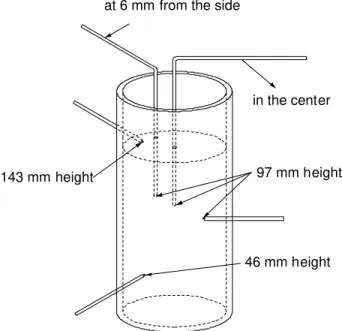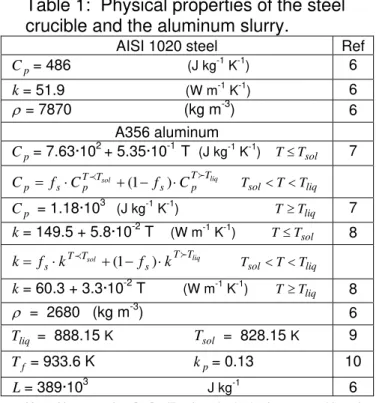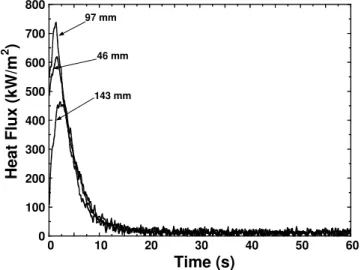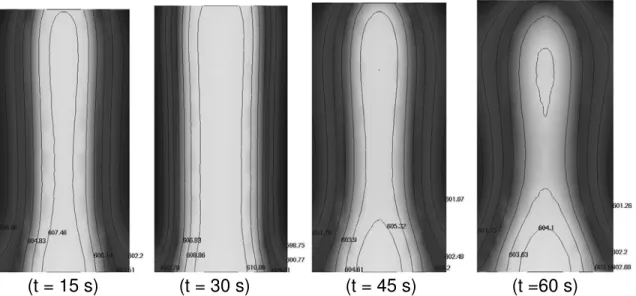Publisher’s version / Version de l'éditeur:
Proceedings. Conférence of Metallurgists (COM, 2003, 2003-08-24
READ THESE TERMS AND CONDITIONS CAREFULLY BEFORE USING THIS WEBSITE.
https://nrc-publications.canada.ca/eng/copyright
Vous avez des questions? Nous pouvons vous aider. Pour communiquer directement avec un auteur, consultez la
première page de la revue dans laquelle son article a été publié afin de trouver ses coordonnées. Si vous n’arrivez pas à les repérer, communiquez avec nous à PublicationsArchive-ArchivesPublications@nrc-cnrc.gc.ca.
Questions? Contact the NRC Publications Archive team at
PublicationsArchive-ArchivesPublications@nrc-cnrc.gc.ca. If you wish to email the authors directly, please see the first page of the publication for their contact information.
NRC Publications Archive
Archives des publications du CNRC
This publication could be one of several versions: author’s original, accepted manuscript or the publisher’s version. / La version de cette publication peut être l’une des suivantes : la version prépublication de l’auteur, la version acceptée du manuscrit ou la version de l’éditeur.
Access and use of this website and the material on it are subject to the Terms and Conditions set forth at
Heat Transfer Analysis of the Swirl Enthalpy Equilbration Device for the Production of Semi-Solid Aluminum
Bouchard, Dominique; Pineau, Frédéric; Doutre, Don; Wales, Peter; Langlais, Joseph
https://publications-cnrc.canada.ca/fra/droits
L’accès à ce site Web et l’utilisation de son contenu sont assujettis aux conditions présentées dans le site LISEZ CES CONDITIONS ATTENTIVEMENT AVANT D’UTILISER CE SITE WEB.
NRC Publications Record / Notice d'Archives des publications de CNRC: https://nrc-publications.canada.ca/eng/view/object/?id=0b2b1de1-f1f5-48cb-bbfe-4e13ee5633eb https://publications-cnrc.canada.ca/fra/voir/objet/?id=0b2b1de1-f1f5-48cb-bbfe-4e13ee5633eb
Heat Transfer Analysis of the Swirl Enthalpy Equilibration
Device for the Production of Semi-Solid Aluminum
Dominique Bouchard(1) , Frédéric Pineau(1) , Don Doutre(2) , Peter Wales(2) and Joseph Langlais(3)
(1) Industrial Materials Institute, National Research Council of Canada, 75 de Mortagne, Boucherville, QC, Canada, J4B 6Y4
(2) Alcan International Limited, Kingston Research Centre, P.O. Box 8400, 945 Princess Street, Kingston, ON, Canada, K7L 5L9
(3) Alcan International Limited, Arvida Research and Development Centre, 1955 Mellon Boulevard, P.O. Box 1250, Jonquière, QC, Canada, G7S 4K8
Abstract
A heat transfer analysis of the Swirl Enthalpy Equilibration Device (SEED) was carried out. Temperatures were measured at different locations on the crucible and in the semi-solid slug. An inverse technique was used to characterize the heat flux at the crucible/slug interface. The fluxes were then used as boundary conditions in a mathematical model to calculate the temperature evolution in the slug. A heat balance on the crucible and the slug was also performed. The experimental and calculated results as well as the mathematical model are presented and discussed.
Introduction
An increasing number of components are die cast with aluminum in the semi-solid condition rather than in the liquid state. The impetus for this change comes from the several advantages that have been identified [1]. Two main routes are used in processing the semi-solid aluminum. The first is termed thixocasting and requires a feedstock with a globular structure to be heated to the semi-solid condition before it is injected in the die casting machine. The feedstock is typically bought in the form of rheocast bars whose structure is produced by mechanical or magnetic stirring during solidification. With this route, a premium must be paid for the globular feedstock and this can reach 40 % the price of dendritic ingots used when processing liquid aluminum. In addition, scrap from runners, biscuits and unsound castings cannot be recycled in the foundry [1]. The adoption of thixocasting has thus been limited to a number of high end castings.
A second route has been developed to produce castings from semi-solid
aluminum more economically. It is termed slurry-on-demand and belongs to the family of rheocasting processes. Aluminum ingots are first melted and a semi-solid slurry with a globular structure is produced by controlled cooling. Once the desired temperature and structure are obtained, the slurry is injected in the press to cast the part. With slurry-on-demand, the feedstock with the globular structure is thus entirely produced in the foundry as opposed to thixocasting that requires it to be obtained from a supplier. Another important distinction with thixocasting is that feedstock is produced by cooling liquid aluminum into the semi-solid region rather than heating solid aluminum.
There are several methods to obtain semi-solid aluminum via slurry-on-demand [1]. This paper deals with a new method where the slurry is produced with the Swirl Enthalpy Equilibration Device (SEED). With SEED, molten aluminum is cooled into the semi-solid temperature range by pouring it in a swirling crucible. Heat is transferred from the aluminum to the crucible until thermal equilibrium is achieved. An advantage of this process is that it does not require any
sophisticated temperature control. The equilibrium temperature of the slurry is simply reached by varying the mass of a given crucible material. Swirling contributes to render the microstructure more globular as well as to promote thermal equilibrium and to prevent adherence of the slurry to the crucible walls. Drainage of part of the liquid in the slurry is also performed to provide an
adequate solid fraction and to assist in making the particles more globular. Greater details on SEED are given by Doutre et al. in these proceedings. Heat transfer to achieve equilibrium between the crucible and the slurry is a fundamental aspect of the process. It is within this equilibrium that the slurry is produced. In this work, the heat flux at the crucible/slug interface was
characterized using an inverse heat conduction technique. This flux was used as a boundary condition in a mathematical model to predict the evolution of
temperature and in the solidifying alloy. A heat balance was also performed to establish the extent of exchanges between the crucible, the slug, and the surroundings.
Experimental
The tests were carried out with ingots of A356 aluminum that were melted in an induction furnace to a temperature of 670 oC. Approximately 0.7 liter of metal was transferred into an alumino-silicate fiber container and cooled to a
temperature of 640 oC. The aluminum was then poured into a steel crucible (AISI 1020) having a diameter of 76 mm, a height of 200 mm and a wall
thickness of 1.14 mm (0.045’’). A mica wash, approximately 0.1 mm thick, was also applied inside the crucible. Three type K surface thermocouples were used to determine the heat flux at the crucible/slurry interface. They were in contact with the outside wall of the crucible and placed at different heights (46, 97 and
143 mm). Two type K grounded thermocouples were also placed in the
aluminum. They were both at a depth of 97 mm but one was located 6 mm from the crucible wall and the other was at 38 mm. All temperatures were recorded with a data logger at a frequency of 10 Hz. The bottom of the crucible was supported by refractory material that permitted drainage. Figure 1 illustrates the crucible with the thermocouple arrangement. Once the crucible was filled with aluminum to a height of approximately 150 mm, it was gently swirled for a period of 50 s. This was followed by a 10 s wait and a 40 s drainage. After this time, the crucible was turned upside down to allow the semi-solid slug to slide. In absence of shear, the viscosity of the slug was high and it was handled as a solid but when shear was applied, the viscosity decreased and the material behaved as a liquid. Five slugs were produced in this manner to establish the repeatability of the temperature measurements.
97 mm height
46 mm height 143 mm height
in the center at 6 mm from the side
Figure 1. Schematic depiction of the thermocouples and the crucible containing the aluminum slurry. The base of the crucible was supported by refractory material (not shown) that permitted drainage. The thermocouples used were specifically designed to measure surface temperatures
Heat Transfer Analysis
It was assumed, in this work that heat from the solidifying metal was
predominantly transferred along the radial direction and that there were also some slight variations along the height of the crucible. The analysis presented here was carried out for the first 60 s of the process, i.e., prior to drainage. The heat fluxes during that 60 s period were determined by performing a 1-D inverse heat conduction analysis with the sequential function specification method
developed by Beck [2]. The fluxes were calculated at three different heights using data from the surface thermocouples shown in Figure 1. The heat flow between each sensor was then calculated assuming linear variations. Heat transfer in the solidifying metal was calculated with the two-dimensional heat-conduction equation in cylindrical coordinates:
t H z T k z r T r k r T k r ∂ ∂ = ⎟ ⎠ ⎞ ⎜ ⎝ ⎛ ∂ ∂ ∂ ∂ + ∂ ∂ + ⎟ ⎠ ⎞ ⎜ ⎝ ⎛ ∂ ∂ ∂ ∂ ρ (1)
With the enthalpy, H , defined as:
( )
T Cp( )
T dt L(
f( )
T H T H s T T o o − + + =∫
1 ) ()
(2)The contribution of the latent heat of fusion, , was approximated with a specific heat function [3]. The solid fraction, , was assumed to depend on temperature and the partition coefficient, , according to:
L s f p k
( )
( )
⎟ ⎟ ⎠ ⎞ ⎜ ⎜ ⎝ ⎛ − ⎥ ⎥ ⎦ ⎤ ⎢ ⎢ ⎣ ⎡ − − − = 1 1 1 p k liq f f s T T t T T T f (3)The above relationship being derived from the Scheil equation [4] assuming constant slopes for the liquidus and solidus. The initial temperature for the aluminum was fixed to 614 oC as given by the results in Figure 2. The following boundary condition was used on the walls of the slug:
( )
i j i r T k t z q ∂ ∂ − = , , (4)In this equation, the heat fluxes, q ,
( )
z t , were those obtained by the inverse technique cited earlier. Free convection was assumed for the top of the slug and yielded a second boundary condition:(
)
i j i amb top r T k T T h ∂ ∂ − = − , (5)A value of 25 W/m2 K was used for the heat transfer coefficient, . A third boundary condition was set for the bottom of the slug by assuming it was perfectly insulated: h 0 , = ∂ ∂ − i j i r T k (6)
The calculations with this mathematical model were performed with finite
elements using the Galerkin gradient least-squares (GGLS) formulation [5]. The physical properties used in the calculations are listed in Table 1.
Table 1: Physical properties of the steel crucible and the aluminum slurry.
AISI 1020 steel Ref
p C = 486 (J kg-1 K-1) 6 k= 51.9 (W m-1 K-1) 6 ρ = 7870 (kg m-3 ) 6 A356 aluminum p C = 7.63·102 + 5.35·10-1 T (J kg-1 K-1) T≤Tsol 7 liq sol T T p s T T p s p f C f C C = ⋅ p +(1− )⋅ f Tsol <T<Tliq p C = 1.18·103 (J kg-1 K-1) T≥Tliq 7 k= 149.5 + 5.8·10-2 T (W m-1 K-1) T≤Tsol 8 liq sol T T s T T s k f k f k= ⋅ p +(1− )⋅ f Tsol<T<Tliq k= 60.3 + 3.3·10-2 T (W m-1 K-1) T≥Tliq 8 ρ = 2680 (kg m-3 ) 6 liq T = 888.15 K Tsol = 828.15 K 9 f T = 933.6 K kp= 0.13 10 L= 389·103 J kg-1 6
Kopp-Neumann law [11] utilized to obtain the heat capacities of the alloys. Composition of the AISI 1020 and A356 alloys obtained from reference [6].
Results and Discussion
Figure 2 illustrates the temperature evolution obtained with the thermocouples imbedded in the slug and those on the outside wall of the steel crucible. The repeatability of the measurements for the five slugs was within 2 oC for the measurements in the slug and 5 oC for those on the crucible walls. The curves shown in this Figure are averages of the five experiments. The two
thermocouples in the slugs reported temperatures that were very close. Although the liquid metal was poured at 640 oC, the initial temperature in the graph is shown to be 614 oC, denoting that superheat was dissipated during pouring. For the crucible, temperatures measured at 46 and 97 mm were almost identical but those at 143 mm were lower. This difference is attributed to the fact that no lid covered the 150 mm slug and some heat was lost to the surrounding air. The temperature rise of the crucible was initially rapid and became slow afterwards. Thermal equilibrium was virtually reached after 20 seconds. It is therefore seen that the process has two distinct heat transfer regimes, being initially unsteady and becoming increasingly steady afterwards. It is also noted from this Figure that the crucible started cooling once drainage was
underway and this cooling was more pronounced at the top. The temperatures measured at 97 mm in the slugs were unaffected by drainage.
0 100 200 300 400 500 600 700 0 20 40 60 80 100 Temperat u re ( °C ) Time (s) SWIRLING WA IT IN G DRAINAGE 97 mm 143 mm 46 mm 38 mm 6 mm
Figure 2. Temperatures measured on the wall of the crucible and in the slug during the production of the semi-solid slurry. The swirling, waiting and drainage periods are also indicated.
In Figure 3, the three heat flow curves obtained with the temperatures measured on the crucible wall are shown. The variation was rapid during the first 20
seconds and became small afterwards. The main differences among these three curves are in the peak values that were attained within 2 seconds. The lowest value was near the top of the slug at a height of 143 mm and the highest was at 97 mm. The results also show that after approximately 3 seconds, the heat flow was virtually the same along the entire height of the crucible.
0 100 200 300 400 500 600 700 800 0 10 20 30 40 50 60 Heat Fl u x (kW/m 2 ) Time (s) 97 mm 46 mm 143 mm
Figure 3. Evolution of heat fluxes at the interface between the crucible and the slug.
In Figure 4, the results of the mathematical modeling are presented at four different times. It is noticed that temperature differences in the slug become increasingly small with time. Just before drainage,
(
t=60s)
, the average temperature calculated for the slug is 603 oC and this is in fair agreement with the value of 606 oC that was measured (Figure 2). A solid fraction ofapproximately 25 per cent is calculated at 603 oC with equation (3). With drainage, liquid aluminum is driven out and this increases solid fraction of the slug. By controlling the duration of this procedure, a desired value can be obtained. A 50 per cent solid fraction is easily achieved and is typical when casting parts.
(t = 15 s) (t = 30 s) (t = 45 s) (t =60 s)
Figure 4. Two-dimensional slices of the temperature evolution in the 150 mm x 76 mm semi-solid slug produced with the SEED process.
As stated earlier, the first 20 s of metal/crucible contact are characterized by an unsteady-state heat flow. The heat balance for such a condition is:
out in acc Q Q
Q = − (7)
Assuming that heat is transferred to the walls of the crucible and none to the bottom, the heat accumulated in the crucible, Qacc, is calculated as:
∫
= T p acc C dT Q 298 (8)Using the results in Figure 2, after 20 s, the average temperature of the lower half of the crucible is 560 oC and 479 oC for the upper half, the latter being obtained assuming a linear temperature profile. The heat capacity, Cp, of the
crucible steel is given in Table 1. From these data, the heat accumulated, , is 103 kJ.
acc
Q
The heat entering the crucible,Qin, is given by:
∫
⋅ = 20 0 A dt q Qin in (9)i.e., the product of the area under a heat flux curve shown in Figure 3 with the surface, A , of the crucible/slug interface. Assuming the curve obtained at 46 mm is representative of the average heat flux, the total heat entering the crucible is then 120 kJ.
The heat leaving the crucible, Qout, is obtained with:
∫
∫
⋅ + ⋅ = 20 0 20 0 A dt q A dt qQout conv rad (10)
The heat flux leaving the crucible by convection,qconv, is expressed as:
) ( wall amb
conv
conv h T T
q = − (11)
With free convection, the heat transfer coefficient, , normally varies between 5 and 25 W/m
conv
h 2
K [12]. The value chosen in the present calculation was 15 W/m2 K. The temperatures at the wall of the crucible, , were obtained from Figure 2. It was assumed that temperatures at 97 mm applied to the bottom half of the crucible. For the top half, a linear variation of temperature with height was
assumed. In this manner, the heat lost by free convection was calculated to be 6 kJ.
wall
T
The heat flux leaving the crucible by radiation, , is obtained with the following relationship: rad q ) ( wall amb rad rad h T T q = − (12)
Where the radiation heat transfer coefficient is defined by [12]:
(
wall amb)
(
wall ambrad T T T T
h =εσ 2 + 2 +
)
(13)In this analysis, the emissivity of the crucible,ε , was taken as 0.8. σ is the Stefan-Boltzmann constant. The outer wall temperature of the crucible,Twall, was
calculated in the same manner as the heat lost by free convection. The ambient temperature,Tamb, was taken as 25 oC. With these assumptions, the heat loss by radiation is calculated to be 12 kJ. The heat leaving the crucible by convection and radiation, , is then 18 kJ. It should be noted that heat losses by radiation are greater than those by free convection (12 and 6 kJ, respectively).
out
Q
It is seen that the heat balance given by equation (7) is correct within 1 kJ. This is difference is small considering the experimental errors in the temperatures measurements and the assumptions that were made.
For the steady-state regime, the heat balance is given by:
out in Q
Q = (14)
Equations (9) and (10) are still used to obtain and but the limits of
integration are between 20 and 60 s. It must be realized that the analysis for the steady-state regime cannot be as accurate as for the unsteady one due to the very low heat flux values shown in Figure 3 for that time period (~15 kW/m
in
Q Qout
2 ). The analysis nevertheless yields values of 22 kJ for the heat entering the crucible,Qin, and 48 kJ for the heat leaving, Qout. An average value of 34 kW/m
2
instead of 15 kW/m2 for the heat flux in Figure 3 would be necessary for the heat input to balance with the output. The scale of the heat fluxes reported in Figure 3 show that this difference is relatively small.
The heat leaving the slug can be estimated from the relationship between
enthalpy and temperature. The results in Figure 2 show that the aluminum in the crucible was initially at 614 oC and at 606 oC after 60 s. The enthalpy calculated with the data in Table 1 yield values of 946 kJ/kg and 894 kJ/kg at these two respective temperatures. The mass of the slug being approximately 1.88 kg, the heat leaving the slug is then 97 kJ compared to the value of heat entering the crucible, , previously calculated to be 120 kJ. The difference can be accounted by uncertainties in the temperature measurements. For example, using data in Table 1, the enthalpy calculated at 604
in
Q
o
C is 881 kJ/kg compared to 894 kJ/kg at 606 oC and this would give an energy output of 121 kJ. The
variation of enthalpy with temperature is large in the mushy zone. The results presented in this study constitute a partial description of the SEED process and further work is planned. The incorporation of two phases and fluid flow in the mathematical model would allow the simulation of drainage. In some instances, a user of the process could consider desirable not to drain the slurry and this aspect needs to be investigated with simulations and experimental validations. Effects of changes in the mass and dimensions of the crucible on the slurry could be forecast by considering both the crucible and the slug in the model. Metallographic examination of quenched samples at various time
solid fractions. The effect of the amount of superheat in the aluminum also needs to be investigated.
Conclusions
The heat transfer in the Swirl Enthalpy Equilibrium Device (SEED) was analyzed and two regimes were identified. During the first 20 s, there is an unsteady-state heat flow after which a steady state is established. Thermal equilibrium between the crucible and the semi-solid aluminum is therefore quickly reached.
Calculations of the temperature evolution in the semi-solid slug indicate that the solid fraction is approximately 25 per cent prior to drainage. Further work will be carried out to determine how certain parameters affect the process, for example, the mass of the crucible on the thermal equilibrium. A heat balance performed on the crucible showed that transfer by radiation was
prominent.
Acknowledgments
Technical assistance from Jean-Paul Nadeau is acknowledged.
Nomenclature
A area of the crucible
s
f solid fraction in the mushy zone.
h contact heat transfer coefficient (kW m-2 K-1) i node identification in the numerical analysis j node identification in the numerical analysis k thermal conductivity (W m-1K-1)
p
k partition coefficient r slug radius (m)
q heat flux per unit surface area (W m-2)
t time (s) z slug height (m) p C heat capacity (J kg-1 K-1) H enthalpy (J kg-1) L latent heat (J kg-1) Q Heat (J) T temperature (K) amb T ambient temperature (K) f
T fusion temperature of pure aluminum (K)
liq T liquidus temperature (K) o T initial temperature (K) sol T solidus temperature (K)
top
T top temperature of the slug (K)
wall
T wall temperature of the slug (K) ε emissivity
ρ density (kg m-3)
σ Stefan-Boltzmann constant (5.670⋅10−8W /(m2⋅K4)
References
[1] Science and Technology of Semi-Solid Metal Processing, Ed. A. de
Figueredo, The North American Die Casting Association, Rosemont, IL, 2001. [2] Beck, J.V., Blackwell, B. and St.Clair, C.R.: Inverse Heat Conduction,
Wiley-Interscience Publication, New York, (1985), 125-172.
[3] Morgan, K. and Lewis, R.W. and Zienkiewicz, O.C.: An improved algorithm for heat conduction problems with phase change, International Journal for Numerical Methods in Engineering, 12 (1978), 1191-1195.
[4] Flemings, M.C.: Solidification Processing, McGraw-Hill Book Co., New York, NY, (1974).
[5] Ilinca, F. and Hétu, J-F.: Galerkin gradient least-squares formulations for transient conduction heat transfer, Comput. Methods Appl. Mech. Engrg. 191 (2002), 3073-3097.
[6] http://www.matweb.com : data sheets for AISI 1020 Steel and Aluminum 356.0-F Casting Alloy.
[7] Kubaschewski, O., Alcock, C. B. and Spencer, P.J.: Materials Thermochemistry, 6th ed., Pergamon Press Ltd., New York, (1993).
[8] Touloukian, Y.S., Powell, R.W., Ho, C.Y. and Klemens, P.G.: Thermophysical Properties of Matter, Plenum Publishing Corp., New York, NY, Vol. 1(1970). [9] Metals Handbook, 9th Edition, ASM International, Materials Park, OH Vol.2
(1992).
[10] ASM Handbook, ASM International, Materials Park, OH, Vol. 3(1992).
[11]Touloukian, Y.S., Powell, R.W., Ho, C.Y. and Klemens, P.G.: Thermophysical Properties of Matter, Plenum Publishing Corp., New York, NY, Vol. 4(1970). [12] D.R. Gaskell: An Introduction to Transport Phenomena in Materials



